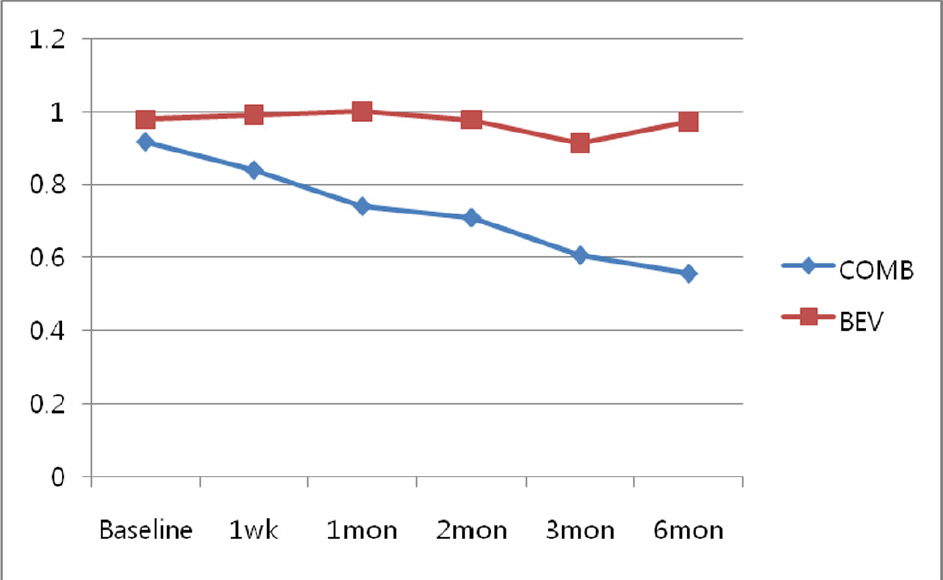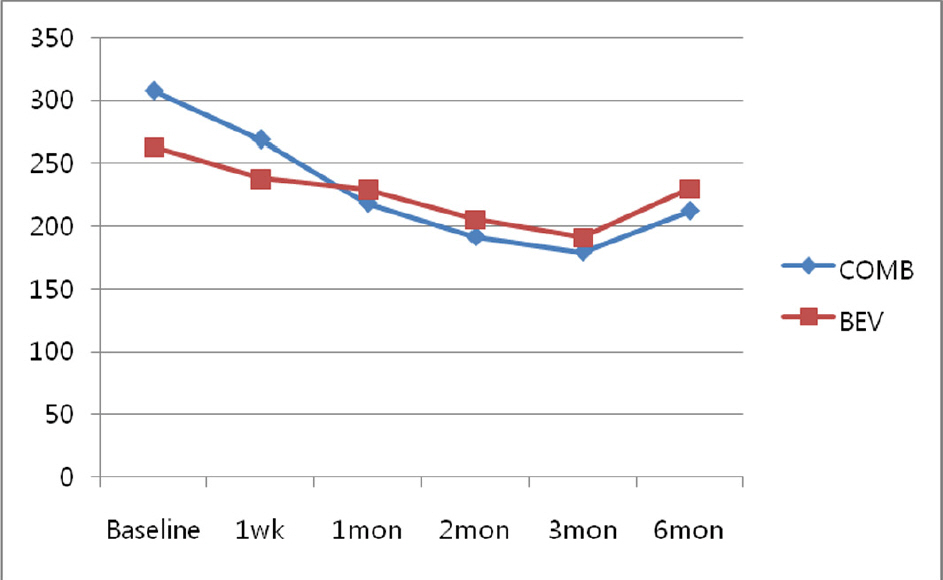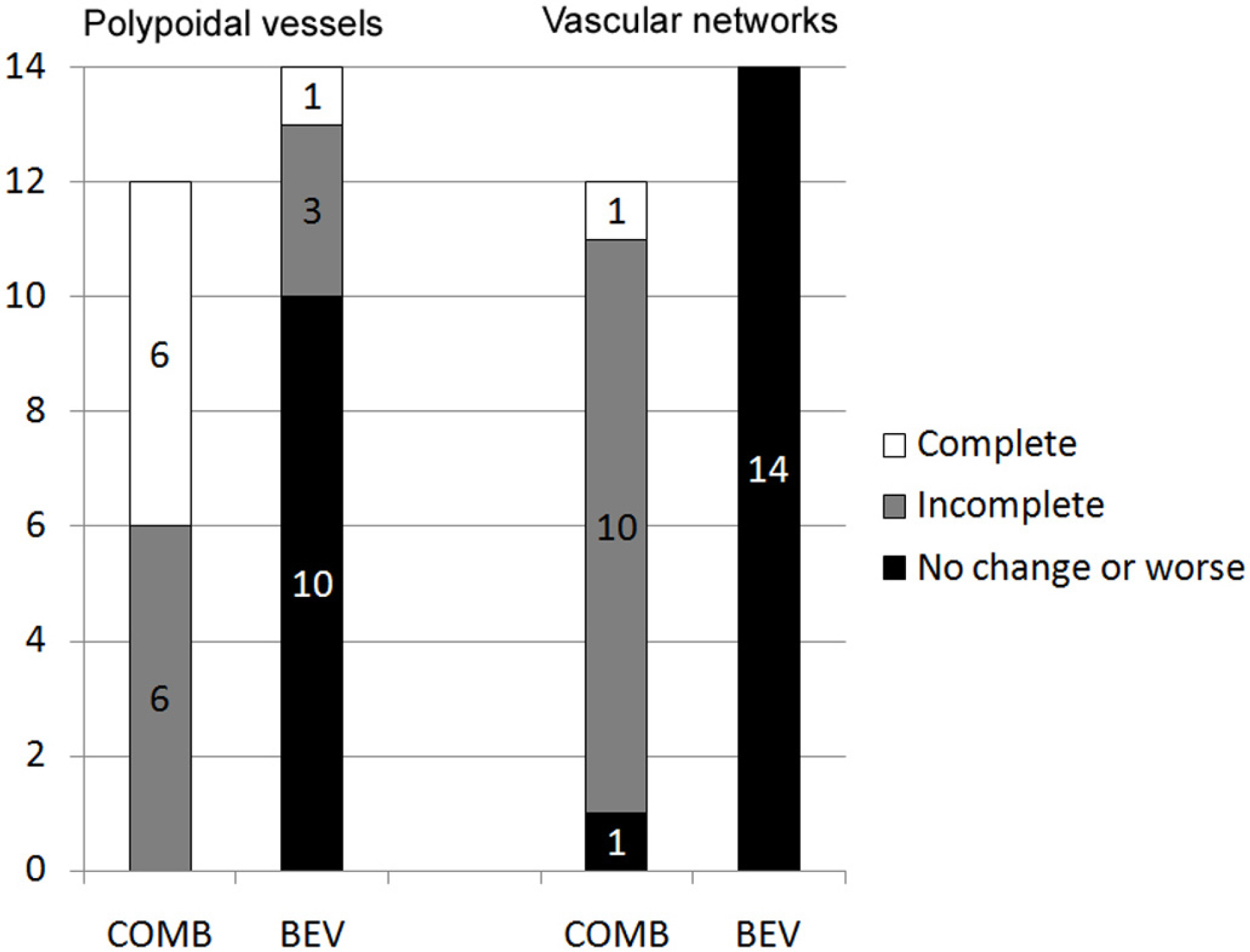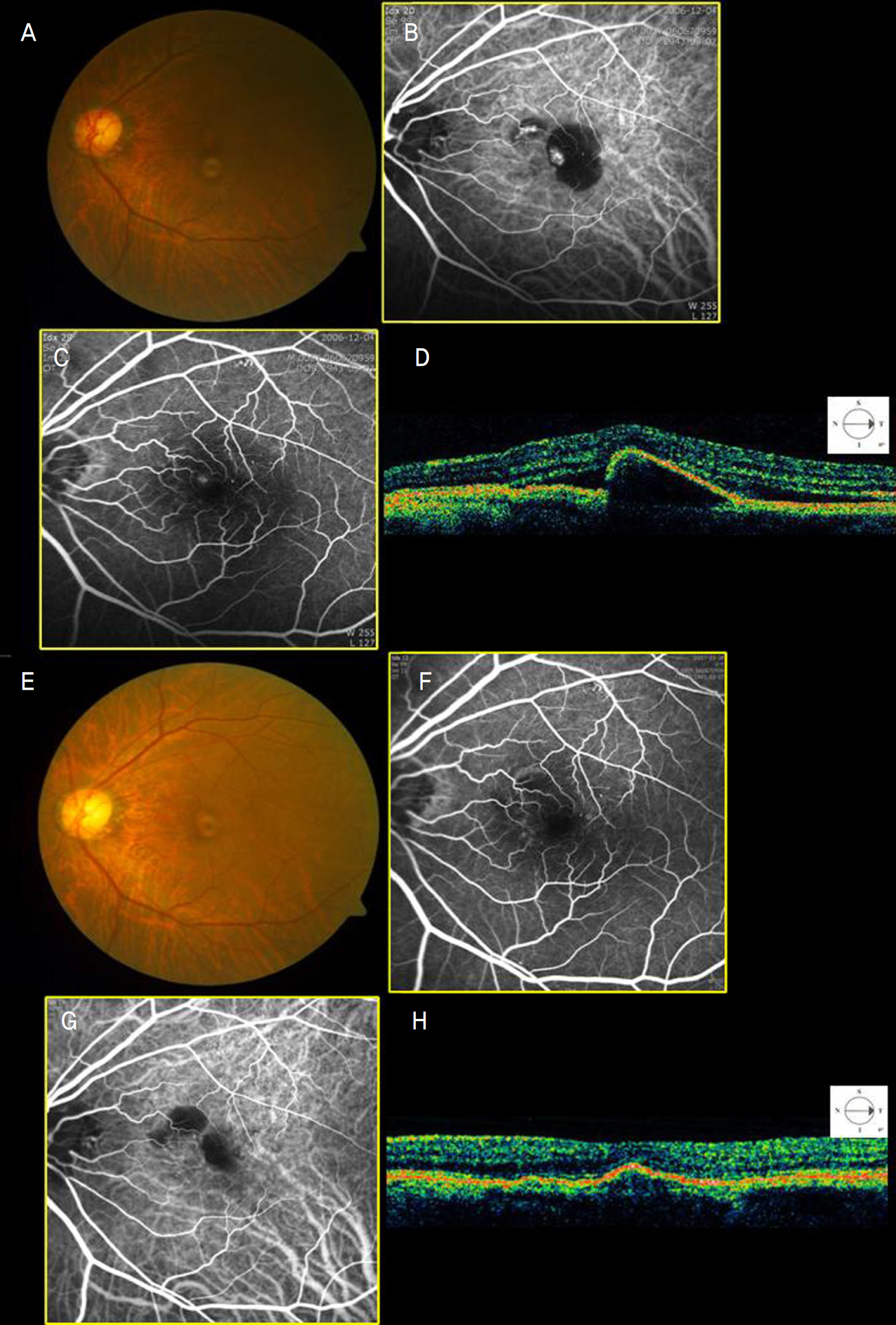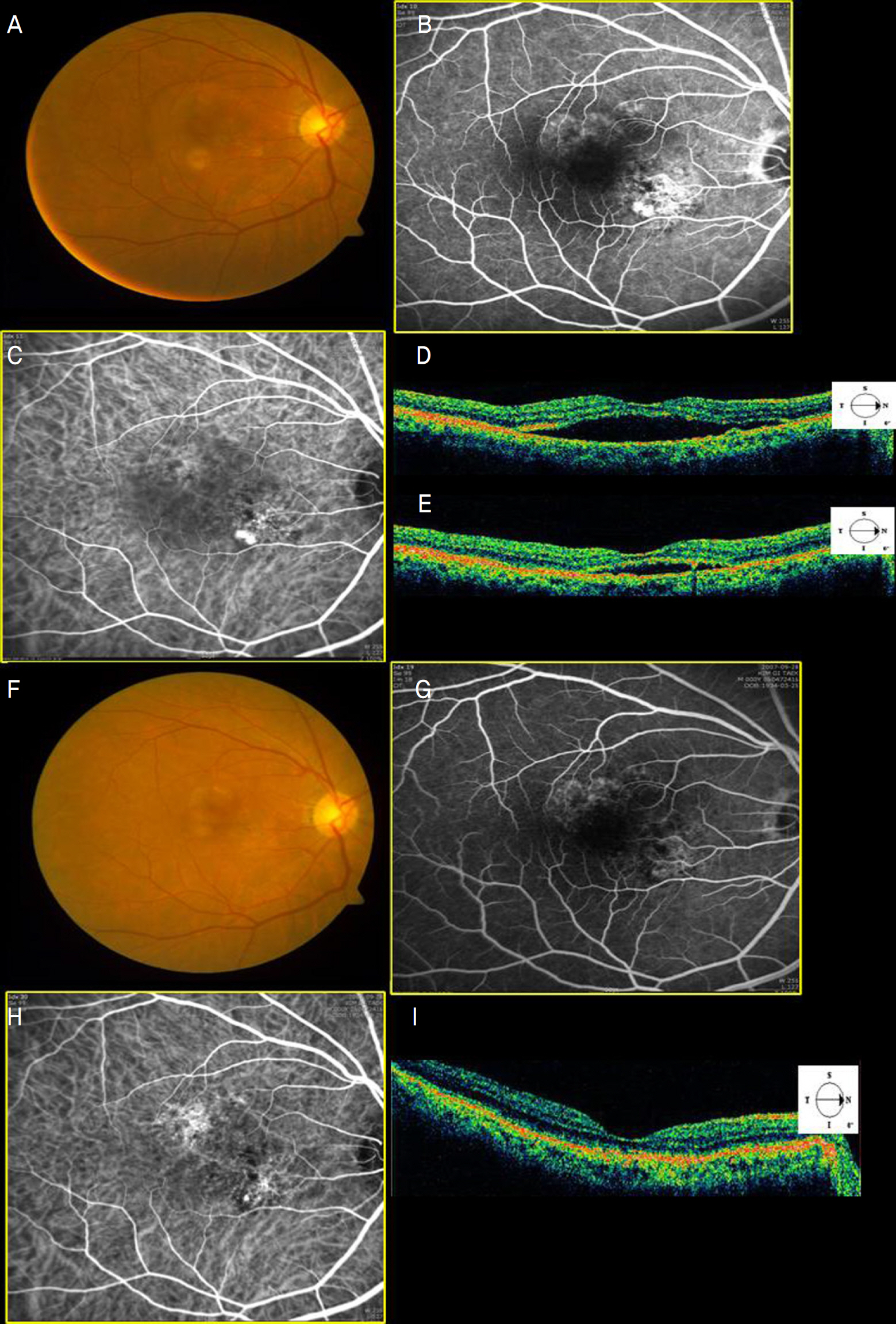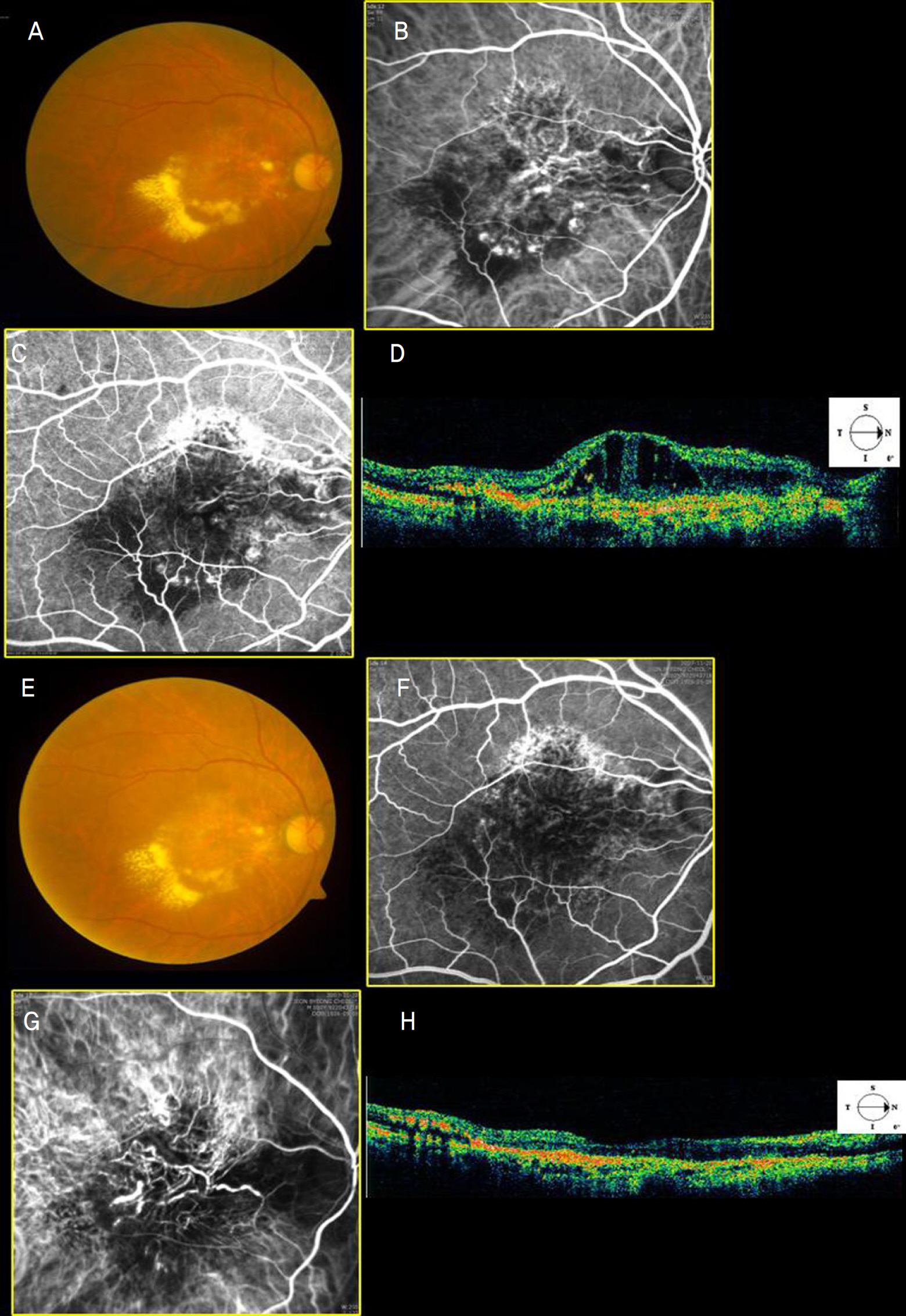J Korean Ophthalmol Soc.
2010 May;51(5):684-692.
Intravitreal Bevacizumab With or Without Photodynamic Therapy for the Treatment of Polypoidal Choroidal Vasculopathy
- Affiliations
-
- 1Department of Ophthalmology, Pusan National University Hospital, School of Medicine, Busan, Korea. jlee@pusan.ac.kr
Abstract
- PURPOSE
To compare the efficacy of photodynamic therapy (PDT) using verteporfin combined with intravitreal bevacizumab and bevacizumab monotherapy in polypoidal choroidal vasculopathy (PCV).
METHODS
Twenty-six eyes, diagnosed with PCV were reviewed retrospectively. They were divided into two groups: combined treatment (COMB) and bevacizumab monotherapy (BEV). Visual acuity, fluorescein angiography (FA) and indocyanine green angiography (ICG) results were reviewed to compare changes in the polypoidal vessels and the branching vascular networks.
RESULTS
Among 26 eyes of 26 patients, there were 12 eyes in the COMB group and 14 eyes in the BEV group. Follow-up periods were about 42 weeks and 48 weeks for the respective groups. In the COMB group, visual acuity improved from log MAR 0.92 to 0.56, whereas visual acuity in the BEV group changed only minimally from log MAR 0.98 to 0.97. In the COMB group, the polypoidal vessel resolved in six eyes. In the BEV group, the polypoidal vessel resolved in one eye. In the COMB group, the vascular network resolved in one eye, improved in ten eyes, and did not change in one eye. In the BEV group, the vascular network did not change in any of the 14 eyes.
CONCLUSIONS
Combined treatment with PDT and intravitreal bevacizumab resulted in a more prolonged effect, induced the resolution of polypoidal vessels more effectively than did bevacizumab monotherapy, and is expected to reduce recurrence and retreatment.
MeSH Terms
-
Angiography
Antibodies, Monoclonal, Humanized
Choroid
Eye
Fluorescein Angiography
Follow-Up Studies
Glycosaminoglycans
Humans
Indocyanine Green
Photochemotherapy
Porphyrins
Recurrence
Retreatment
Retrospective Studies
Triazenes
Visual Acuity
Bevacizumab
Antibodies, Monoclonal, Humanized
Glycosaminoglycans
Indocyanine Green
Porphyrins
Triazenes
Figure
Reference
-
References
1. Yannuzzi LA, Sorenson J, Spaide RF, Lipson B. Idiopathic polypoidal choroidal vasculopathy (IPCV). Retina. 1990; 10:1–8.
Article2. Spaide RF, Yannuzzi LA, Slakter JS, et al. Indocyanine green abdominal of idiopathic polypoidal choroidal vasculopathy. Retina. 1995; 15:100–10.3. Yannuzzi LA, Ciardella A, Spaide RF, et al. The expanding clinical spectrum of idiopathic polypoidal choroidal vasculopathy. Arch Ophthalmol. 1997; 115:478–85.
Article4. Lee WK, Kwon SI. Polypoidal choroidal vasculopathy. J Korean Ophthalmol Soc. 2000; 41:2573–84.5. Uyama M, Matsubara T, Fukushima I, et al. Idiopathic polypoidal abdominal vasculopathy in Japanese patients. Arch Ophthalmol. 1999; 117:1035–42.6. Uyama M, Wada M, Nagai Y, et al. Polypoidal choroidal vasculopathy: natural history. Am J Ophthalmol. 2002; 133:639–48.7. Yuzawa M, Mori R, Haruyama M. A study of laser photocoagulation for polypoidal choroidal vasculopathy. Jpn J Ophthalmol. 2003; 47:379–84.
Article8. Spaide RF, Donsoff I, Lam DL, et al. Treatment of polypoidal abdominal vasculopathy with photodynamic therapy. Retina. 2002; 22:529–35.9. Silva RM, Figueira J, Cachulo ML, et al. Polypoidal choroidal abdominal and photodynamic therapy with verteporfin. Graefes Arch Clin Exp Ophthalmol. 2005; 243:973–9.10. Lee PY, Lee WK. Changes of Network Vessels after Photodynamic Therapy in Polypoidal Choroidal Vasculopathy. J Korean Ophthalmol Soc. 2006; 47:1751–8.11. Ghajarnia M, Kurup S, Eller A. The Therapeutic Effects of Intravitreal Bevacizumab in a patient with Recalcitrant Idiopathic Polypoidal Choroidal Vasculopathy. Semin Ophthalmol. 2007; 22:127–31.
Article12. Gomi F, Sawa M, Sakaguchi H, et al. Efficacy of intravitreal abdominal for polypoidal choroidal vasculopathy. Br J Ophthalmol. 2008; 92:70–3.13. Lazic R, Gabric N. Verteporfin therapy and intravitreal bevacizumab combined and alone in choroidal neovascularization due to age-abdominal macular degeneration. Ophthalmology. 2007; 114:1179–85.14. Costa RA, Jorge R, Calucci D, et al. Intravitreal bevacizumab (Avastin) in combination with verteporfin photodynamic therapy for choroidal neovascularization associated with age-related macular degeneration (IBeVe Study). Graefes Arch Clin Exp Ophthalmol. 2007; 245:1273–80.
Article15. Lai TY, Chan WM, Lam DS. Transient reduction in retinal function abdominal by multifocal electoretinogram following photodynamic therapy. Am J Ophthalmol. 2004; 137:826–33.16. Tatar O, Adam A, Shinoda K, et al. Expression of VEGF and PEDF in choroidal neovascular membranes following verteporfin photo-dynamic therapy. Am J Ophthalmol. 2006; 142:95–104.
Article17. Tatar O, Shinoda K, Adam A, et al. Effect of verteporfin photo-dynamic therapy on endostatin and angiogenesis in human choroidal neovascular membranes. Br J Ophthalmol. 2007; 91:166–73.
Article18. Gragoudas ES, Adamis AP, Cunningham ET Jr, et al. Pegatanib for abdominal age-related macular degeneration. N Engl J Med. 2004; 351:2805–16.19. Spaide RF, Laud K, Fine HF, et al. Intravitreal Bevacizumab treatment of choroidal neovascularization secondary to age-related macular degeneration. Retina. 2006; 26:383–90.
Article20. Emerson MV, Lauer AK, Flaxel CJ, et al. Intravitreal bevacizumab (Avastin) treatment of neovascular age related macular degeneration. Retina. 2007; 27:439–44.21. Rosenfeld PJ, Brown DM, Heier JS, et al. Ranibizumab for neovascular age-related macular degeneration. N Eng J Med. 2006; 355:1419–31.
Article22. Takeda AL, Colquitt J, Clegg AJ, et al. Pegaptanib and ranibizumab for neovascular age-related macular degeneration: a systemic review. Br J Ophthalmol. 2007; 91:1177–82.23. Matsuoka M, Ogata N, Otsuji T, et al. Expression of pigment abdominal derived factor and vascular endothelial growth factor in abdominal neovascular membranes and polypoidal choroidal vasculopathy. Br J Ophthalmol. 2004; 88:809–15.24. Tong JP, Chan WM, Liu DT, et al. Aqueous humor levels of vascular endothelial growth factor and pigment epithelium-derived factor in polypoidal choroidal vasculopathy and choroidal neovascularization. Am J Ophthalmol. 2006; 141:456–62.
Article25. Lai TY, Chan WM, Liu DT, et al. Intravitreal bevacizumab (Avastin) with or without photodynamic therapy for the treatment of abdominal choroidal vasculopathy. Br J Ophthalmol. 2008; 92:661–6.26. Reche FJ, Calvo GC, Donate LJ, et al. abdominal anatomic effect of ranibizumab for polypoidal choroidal vasculopathy. Eur J Ophthalmol. 2008; 18:645–8.27. Yuzawa M, Mori R, Kawamura A. The origins of polypoidal choroidal vasculopathy. Br J Ophthalmol. 2005; 89:602–7.
Article28. Yuzawa M, Mori R, Kawamura A. Clinicopathologic findings in abdominal choroidal vasculopathy. Invest Ophthalmol Vis Sci. 2008; 49:4729–37.
- Full Text Links
- Actions
-
Cited
- CITED
-
- Close
- Share
- Similar articles
-
- Combined Photodynamic Therapy and Intravitreal Bevacizumab Injection for Exudative Age-Related Macular Degeneration and Polypoidal Choroidal Vasculopathy
- Photodynamic Therapy with Verteporfin in Polypoidal Choroidal Vasculopathy
- The Therapeutic Effects of Bevacizumab in Patients with Polypoidal Choroidal Vasculopathy
- Short-term Efficacy of Intravitreal Bavacizumab for Polypoidal Choroidal Vasculopathy
- Long-term Results of Reduced-fluence Photodynamic Therapy Combined with Intravitreal Anti-Vascular Endothelial Growth Factor for Polypoidal Choroidal Vasculopathy

